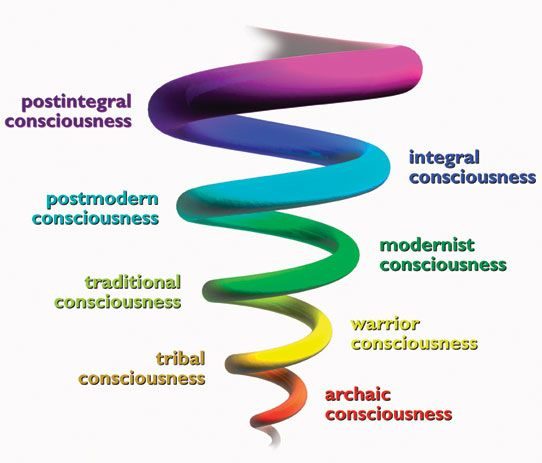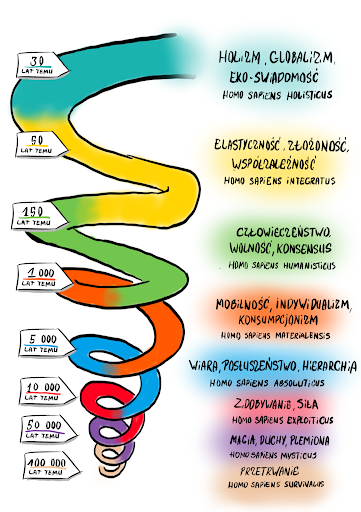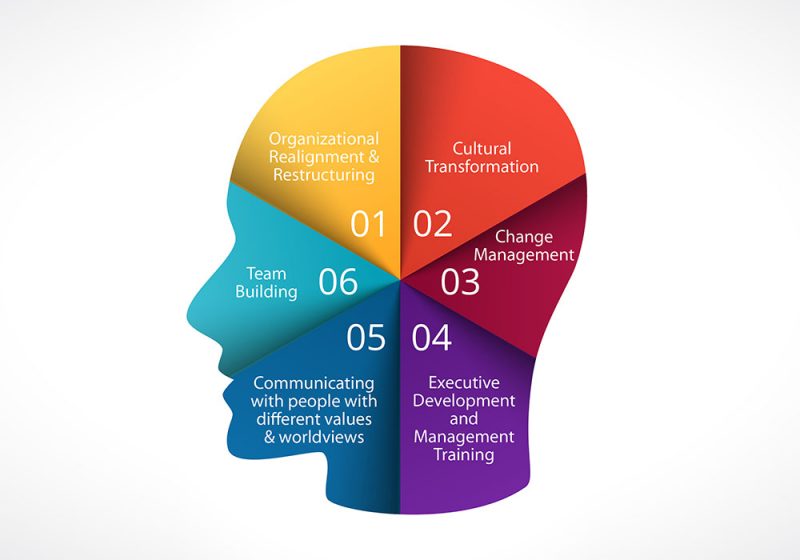What is Spiral Dynamics?
If you’re looking for an integral theory of happiness, you’ve just found it.
Spiral Dynamics, what this article is about, explains why people at different stages of their lives seek happiness in different places, and then, after finding happiness in a given place, seek further and discover it at the next stage of their development. The following article explains how this theory was discovered and why it may be the greatest discovery you are currently looking for.

Spiral Dynamics is also known as Value Level Theory or Integral Theory. It is the result of many years of research by the professor of psychology Clare W. Graves. His research was inspired by a frequent question he received from students:
“Professor Graves: which of the psychological theories you are teaching us are correct? Which one should we stick to? ”.
The professor could not find one easy answer to this question, because in the 1950s, psychology had many varieties, not always consistent with each other. However, when Professor Graves started asking people a relatively simple question: “What is important to you in life?” , it turned out that he received different answers depending on the age of the subject, the gender, what he does and where he lives. These different answers, after examining thousands of people, formed one, coherent whole. The result of this research was the integral theory of human development and Graves’ Levels of Value.
Integral Theory of Happiness, Graves’ Theory of Value explains how different values and the underlying motivation behind values drive a person to develop.
Graves developed this integral concept of human development, proving it both in the development of every human being: from an infant to an old man, and from an anthropological point of view from the beginning of human existence to the present day. Graphically, this Value Level Theory has adopted the double helix – helix model.
His work was temporarily stopped due to the premature death of the professor, but was and is still being continued by his subsequent students – Dr. Don Edward Beck and Christopher Cowan , who shortened the name of the method and research for Spiral Dynamics, which in Polish was called Spiral Dynamics. It was popularized in the world by Ken Wilber in many of his books, and in Poland Marek Wzorek in his book “From hierarchy to turquoise, or how to manage in the 21st century” devoted two chapters to an elegant and clear explanation of the basics and examples of this theory.
What is Spiral Dynamics, how can it be used and what are the different levels of this model?
What is Spiral Dynamics?
Through the assumptions of Spiral Dynamics, we are able to understand why we think and behave a certain way, and why other people do it differently. Graves’ Theory of Value gives us an answer to how we develop as individuals, organizations, and societies, and how our levels of consciousness change. This method can be used in various areas, such as coaching, human development, education, culture, business, interpersonal relations and even economics. Spiral Dynamics identifies 8 levels of development of human consciousness, which are referred to as vMeme – these levels are available to everyone, which means that each of us can be at a certain level of our own development, but not everyone does it. Everything depends on factors such as life decisions that we make, whether and what we learn, what we do, the choice of people with whom we have contact, work, society and the country we live in. It was Dr. Don Edward Beck and Christopher Cowan who developed the colors of each level for the created model, which makes it much easier to perceive today.
How were the different levels of value created? People have struggled with all kinds of problems, living conditions and challenges since ancient times. Each level at which a person happened to be, required a specific way of thinking, acting and adapting. In this way, new levels of human development and happiness are created. These changes result from increasing our awareness and the changes taking place in ourselves and in the world. Each subsequent level brings new opportunities, problems and challenges that “force” the ability to solve them and make our values change with each new level, thanks to a different perspective that is created in our mind. This is how man develops. So let’s go through the individual vMeme levels and colors to better understand the concept of Spiral Dynamics.

Source: Marek Wzorek – “From hierarchy to turquoise, or how to manage in the 21st century”
BEIGE COLOR – SURVIVAL – 100,000 YEARS AGO
The first level of Graves’ values is characteristic of the beginning of humanity, and its key value is survival. Human behavior is determined by the senses and instincts such as hunger, thirst, and procreation. The most important thing is to maintain life and “reflect threats” – so this level does not include concepts such as happiness or fulfillment. Man at this level is not aware that he is thinking.
Babies go through the same period of time right after birth. The need to survive is a key need.
When is this level of value activated in adult and contemporary people? At times of danger, such as collective panic, during a flood, in situations where the need to survive and preserve life is activated.
PURPLE COLOR – MAGIC, SPIRITS, TRIBES – 50,000 YEARS AGO
The next level of Spiral Dynamics follows from the previous one and reveals the need to belong to a group that can give a person a sense of security and protection. This causes tribes to form and form groups. Rituals and rituals begin to be created to explain natural phenomena that are still something strange, magical for man. Tradition, tribe, family and respect for elders are important at this stage. There may be resistance and fear of change due to a strong attachment to tradition.
When is this value level active? It can be noticed in the process of building relationships with the family, but also in sports teams, which have a bit of a “tribal” form.
COLOR RED – WINNING AND STRENGTH – 10,000 YEARS AGO
The red color in the Spiral Dynamics model means complete self-centeredness and focus on self and gaining power. At this stage, man decides to regain his individuality and at all costs decides to get what he wants to satisfy his needs. 10,000 years ago it was a time for people who wanted to gain power to conquer the world by violence. The most important thing at this level is strength.
When is this value level active? During war, among dictators, in situations where a person is able to kill another person. But the red tier can also be seen among children who try to dominate their parents and get what they want by “extorting” and becoming furious.
BLUE – FAITH, OBEDIENCE, HIERARCHY – 5,000 YEARS AGO
The next spiral level is blue. At this level, there is only one correct way to do something – everything else is wrong. Different things are divided into two poles: white or black, good and bad, there is nothing “in the middle.” People are to obey, believe in God and the only absolute truth. On the one hand, this level is inflexible, structural and imposes many limitations, on the other hand, it is predictable and can ensure stable development.
When is this value level activated? When you need to arrange chaotic processes inherited from the red stage. It occurs in very highly hierarchical organizations that have a lot of rules, orders, where people are often subordinate to their boss, he to another boss, another boss to the boss, then to the chief leader, president or pope.
ORANGE – MOBILITY, INDIVIDUALISM, CONSUMPTION – 1,000 YEARS AGO
The order imposed by the previous value level again makes you want to stand out as an individual. This time there are also consumerism, materialism, economic growth (industrial and technological revolution). Man here believes that material things define him and wants to get everything that is the best and the most expensive. The good side of the orange level is progress and innovation. At this level, people can be greedy, greedy, and are able to sacrifice a great deal to get the material things they want, which, after all, cannot bring happiness or fulfillment and only enjoy for a while.
When is this value level active? It is visible among many people today. It is activated in adolescence, at the age of reaching adulthood. It manifests itself in the need to collect all kinds of gadgets, phones, computers, cars.
GREEN – HUMANITY, FREEDOM AND CONSENSUS – 150 YEARS AGO
This is the first value level in Spiral Dynamics, which is aware of all previous and next levels (this was not possible in the previous value stages) and will try to use them. The key values we find here are harmony, equality, empathy and tolerance. It also focuses largely on ecology, although it does not find ready solutions to systemic problems. This level wants to ensure the common good and equality of all people, which causes a departure from hierarchy again and from thinking as an individual and more as “all people”.
When is this value level active? It manifests itself on the level of a person with a family, children, and thinking about others. You can find it, among others at employees in organizations dealing with ecology.
COLOR YELLOW – FLEXIBILITY, COMPLEXITY, COOPERATIVE – 50 YEARS AGO
The value that fully reflects the meaning of this level is the ability to make quick decisions taking into account the long-term perspective. This is necessary to overcome the problems of the previous levels and to implement the previous values in a new way. Yellow is associated with an increased level of creativity and more ideas people have at this level of consciousness. It is still important to maintain harmony, but at this stage, this harmony is to be kept with the awareness of all previous stages – then they can use their good sides.
When is this value level active? Among others in coaching processes, at workshops stimulating creative thinking. He performs among jazz musicians, painters, artists, actors – especially improvised theaters.
TURQUOISE COLOR – HOLISM, GLOBALISM, ECO-AWARENESS – 30 YEARS AGO
Very few people are at this level of Spiral Dynamics. Its main assumption is to treat the entire planet as one large organism in which each organism is equally important (which excludes the feeling that man is the most important being in the world). The key values for this world are: empiricism, spirituality, holism, harmony, collective consciousness. This world operates on meta levels, takes a global point of view, sees all possible internal connections.
When is this value level active? Only at the moment of going through all the previous levels and feeling of your “I” as part of a larger, conscious whole and global networks.

How does understanding Spiral Dynamics help you live more consciously?
Spiral dynamics allow us to understand what stage of life we are at. It is a great tool for coaches and people helping in the development of other people, teams, organizations and communities, if they know them well. However, due to the fact that the theory and method is easy only at first glance, people themselves are usually not aware of the level of value that is most common to them, and it is for this reason that it is best to use the services of a coach who knows this method and has been successful in successfully transforming its clients through life changes. You can easily find such coaches in the ecoCoach team.
Understanding the mechanisms of Spiral Dynamics helps you to move through change faster and develop new beliefs, skills and habits. A certain stage of Spiral Dynamics that a person is at is related to certain beliefs, a certain way of thinking and the ways of making decisions. All of this is related to specific values and behaviors assigned to specific colors of the spiral. It is worth remembering that entering the next levels does not mean that the previous ones will disappear. They will be integrated into the next stage and broaden your perspective and thinking, thanks to which you will have a greater sense of fulfillment, happiness, freedom in choosing and making certain decisions and behaviors. At the same time, only entering the seventh level of the spiral allows you to gain awareness related to the previous levels and allows you to understand their values (which is excluded by levels 1-6, focused only on your own values and beliefs).
The authors of the theory of Spiral Dynamics proved that using the individual colors of the spiral helps to alleviate or even eliminate interpersonal conflicts. Beck and Cowan do not identify levels with a specific person, but rather with a specific situation or stage in life in which they are. As Marek Wzorek writes in the book “From hierarchy to turquoise, or how to manage in the 21st century”: “Graves’ levels of values are contextual. Just as we have a different set of behaviors in different situations, so too may different values be important to us in different circumstances. We can represent a different level of spiral dynamics in an emergency and a different level when we are in a state of contentment and deep peace. ” Interestingly, this idea allows us to understand that the wars, conflicts and problems of this world do not arise from racial, economic or religious differences between people – but they arise from differences in levels of values.
In exactly the same way, the mechanisms of Spiral Dynamics can be observed in companies and organizations. People with similar values simply got together in them. These people are starting to create red, orange, green or turquoise organizations, which have specific features and create a specific organizational culture, but this is a topic for the next article, and you will find most of it in the book “From hierarchy to turquoise, or how to XXI century “which you can buy tutaj or in good bookstores, eg Empik.


No comment yet, add your voice below!